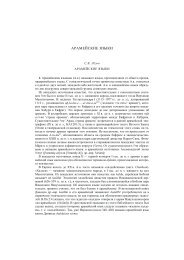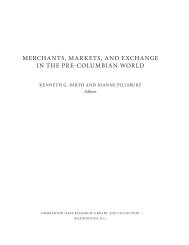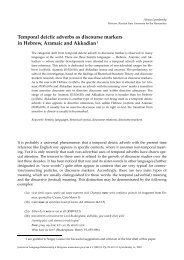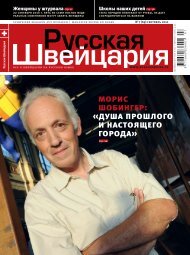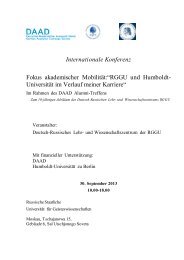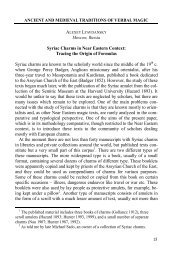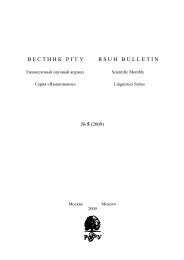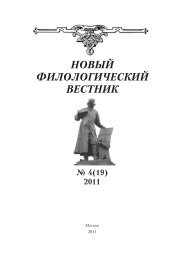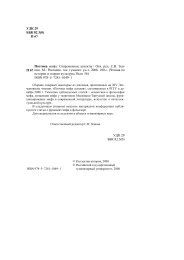Akkadian Sentences about the Present Time (II/2)
Akkadian Sentences about the Present Time (II/2)
Akkadian Sentences about the Present Time (II/2)
Create successful ePaper yourself
Turn your PDF publications into a flip-book with our unique Google optimized e-Paper software.
778 Morphosyntax and Text Structure in <strong>Akkadian</strong>an atelic motion verb, it is more in <strong>the</strong> way of ‘to get nearer/closer’ to agoal, ‘to approach’ it than ‘to arrive’ (= ‘to reach a goal’), and <strong>the</strong>refore itis more at home when <strong>the</strong> event of motion towards a goal is consideredfrom an imperfective viewpoint. 50 Now, <strong>the</strong> above-mentioned prefixingforms of <strong>Akkadian</strong>, including <strong>the</strong> future-time Pres., always have perfectivereadings (Loesov 2005). For this reason, <strong>the</strong> Pret./Prec., t-Perf., andfuture-time (perfective) Pres. of qerēbum are rare. 51 For <strong>the</strong> letter-writersof our corpus to use <strong>the</strong> prefixing tenses of qerēbum was to overstrain <strong>the</strong>atelic meaning of <strong>the</strong> root, <strong>the</strong>re emerged a conflict between <strong>the</strong> lexicalroot meaning and <strong>the</strong> aspectual meaning of <strong>the</strong> respective inflectionalbases. As for <strong>the</strong> ongoing atelic approaching, it is encoded by <strong>the</strong> SC, byfar <strong>the</strong> most frequent finite form of qerēbum in <strong>the</strong> epistolary corpus. 52 Forthis verb, <strong>the</strong> contrast between <strong>the</strong> present-time SC and (rarely used) perfectivefuture-time Pres. can be visualized by <strong>the</strong> following pair of examplesfrom <strong>the</strong> OB divination apodoses: U 4 -ma-tu-šu qé-er-ba: ‘(If a man isdistinguished by beautiful hair <strong>the</strong> end of ) his days is near/approaching’(AfO 18, p. 63:18) vs. šumma naplaštum ana padānim iq-te-er-ba-am tu-ruku-tumana šarrim i-qé-er-ri-bu-nim-ma a-PI-EL-šu ekallam ibêl ‘If <strong>the</strong> spy-holehas approached <strong>the</strong> path, <strong>the</strong> Turukkeans will approach <strong>the</strong> king, and<strong>the</strong>n <strong>the</strong>ir man/his heir will take over <strong>the</strong> palace’ (YOS 10, 11 ii 14–17).The suggestion that <strong>the</strong> SC of a motion verb should code an ongoingevent of movement at all might look bizarre, yet it is to a certain extentcorroborated by <strong>the</strong> OA verb phrase naš!-am ‘he is carrying (something)to where you are’ (Loesov 2005:128ff.) and <strong>the</strong> observations on <strong>the</strong> SC of¢eûm ‘to approach’ below. Cross-linguistically, this situation has a nontrivialparallel in <strong>the</strong> Modern Western Aramaic (MWA). 53 This languagehas a resultative (etymologically denominative) verb form with <strong>the</strong> base50For previous research on <strong>the</strong> semantics of qerēbum, see Kouwenberg 1997:234, 399.51AbB 11, 39:9′ (a-qè-er-r[u-ba-ak-ki-im] ‘I will travel to you’) would be <strong>the</strong> onlytoken of <strong>the</strong> future-time Pres. I have found in letters, yet <strong>the</strong> restoration of <strong>the</strong>Edition is not 100% reliable, and <strong>the</strong> GI sign (= qè) is an unusual means of rendering[qe] in this verb.52The lack of <strong>the</strong> ventive on <strong>the</strong> SC of qerēbum in its (as I believe) motion readingsis probably also related to <strong>the</strong> basic atelicity of this verb. The (in)compatibilityof <strong>the</strong> ventive with inflectional forms of motion verbs depending on <strong>the</strong>ir aspectualand lexical properties requires a special study.53The most recent description of its phonology and morphology is Arnold1990.




